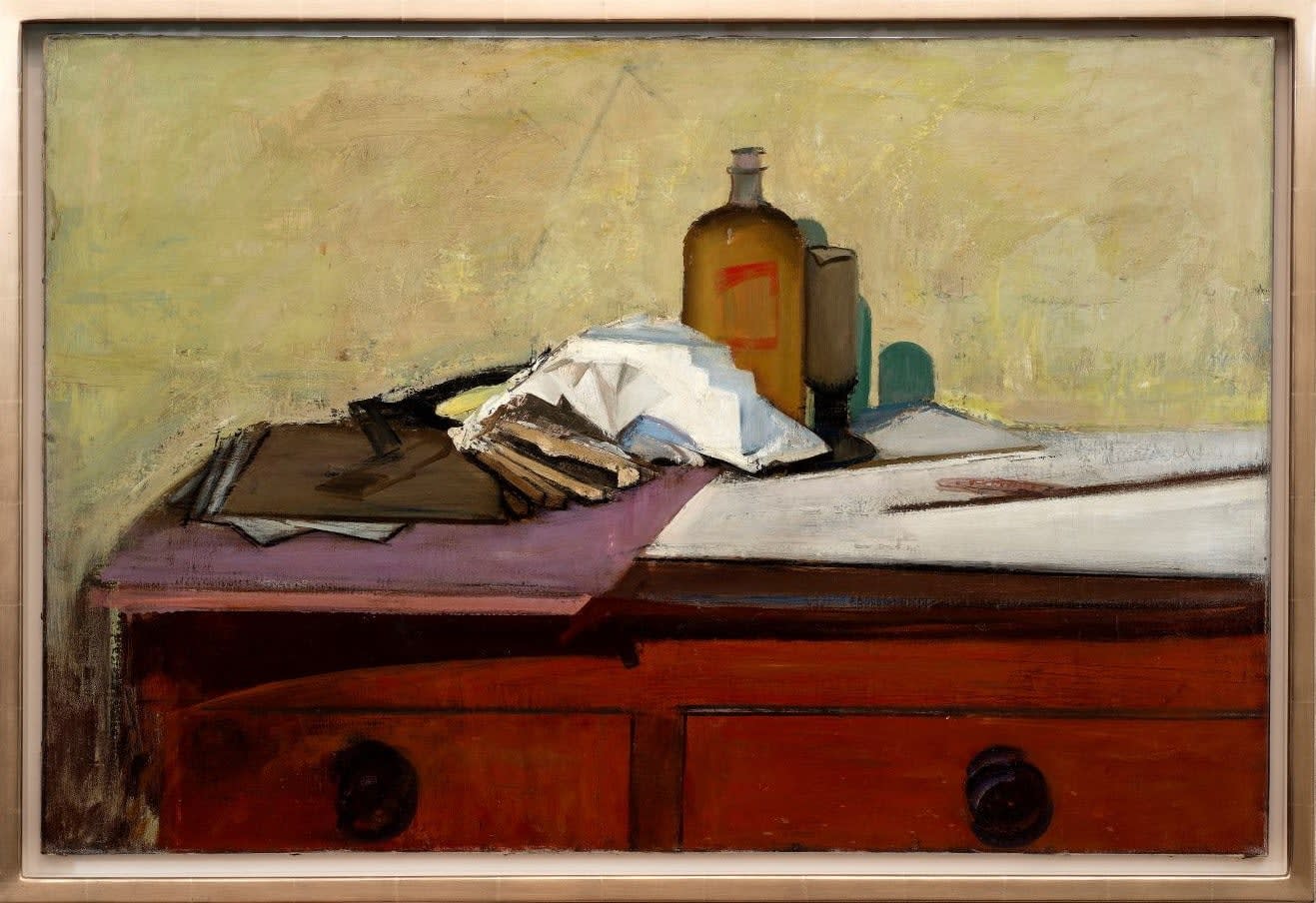Rodrigo Moynihan RA (1910 - 1990)
Still life with books and bottles on a chest, Circa 1950
Oil on Canvas
23.62 x 35.43ins (60 x 90cm) (artwork size)
26.38 x 38.58ins (67 x 98cm) (framed size)
26.38 x 38.58ins (67 x 98cm) (framed size)
Copyright The Artist
£ 18,000.00 + ARR
Further images
Rodrigo Moynihan (1910–1990) was an English painter renowned for his diverse artistic journey. Born in Santa Cruz de Tenerife, Canary Islands, Moynihan's family relocated to London in 1918. Inspired by...
Rodrigo Moynihan (1910–1990) was an English painter renowned for his diverse artistic journey. Born in Santa Cruz de Tenerife, Canary Islands, Moynihan's family relocated to London in 1918. Inspired by a winter in Rome in 1927–1928, he pursued art, eventually studying at the Slade School of Fine Art.
In the 1930s, Moynihan emerged as a pioneer of abstract painting in England, associated with the Objective Abstraction movement. Later, he transitioned to social realism, aligning with the Euston Road School and focusing on representational painting, including still life, interiors, and portraiture.
After World War II, Moynihan held a professorship at the Royal College of Art and became a full member of the Royal Academy in 1954. During this period, he was sought after for official portraits, including notable figures such as Princess Elizabeth and Prime Minister Clement Attlee. However, in 1957, he returned to abstraction, working internationally.
By 1971, Moynihan shifted back to figurative painting, producing large-scale studio still-lives and portraits, including notable commissions of figures like Prime Minister Margaret Thatcher and Dame Peggy Ashcroft.
Throughout his career, Moynihan's works found homes in prominent British institutions including the Glasgow Museums, Derby Art Gallery and in the Imperial War Museum. His legacy remains as a versatile artist who navigated between abstraction and representation with innovation and finesse. The variety of his works was described by the British Art Historian Richard Shone as an expression ‘[…] of both a complex inheritance and training, and a restless intellect that has opened doors rather than closed them in his search for what and how to paint over the last fifty years and more’*1.
*1 Richard Shone (1988), ‘The Art of Rodrigo Moynihan’ in ‘Rodrigo Moynihan, Paintings and Works on Paper’, Thames & Hudson Ltd, p.15.
In the 1930s, Moynihan emerged as a pioneer of abstract painting in England, associated with the Objective Abstraction movement. Later, he transitioned to social realism, aligning with the Euston Road School and focusing on representational painting, including still life, interiors, and portraiture.
After World War II, Moynihan held a professorship at the Royal College of Art and became a full member of the Royal Academy in 1954. During this period, he was sought after for official portraits, including notable figures such as Princess Elizabeth and Prime Minister Clement Attlee. However, in 1957, he returned to abstraction, working internationally.
By 1971, Moynihan shifted back to figurative painting, producing large-scale studio still-lives and portraits, including notable commissions of figures like Prime Minister Margaret Thatcher and Dame Peggy Ashcroft.
Throughout his career, Moynihan's works found homes in prominent British institutions including the Glasgow Museums, Derby Art Gallery and in the Imperial War Museum. His legacy remains as a versatile artist who navigated between abstraction and representation with innovation and finesse. The variety of his works was described by the British Art Historian Richard Shone as an expression ‘[…] of both a complex inheritance and training, and a restless intellect that has opened doors rather than closed them in his search for what and how to paint over the last fifty years and more’*1.
*1 Richard Shone (1988), ‘The Art of Rodrigo Moynihan’ in ‘Rodrigo Moynihan, Paintings and Works on Paper’, Thames & Hudson Ltd, p.15.







